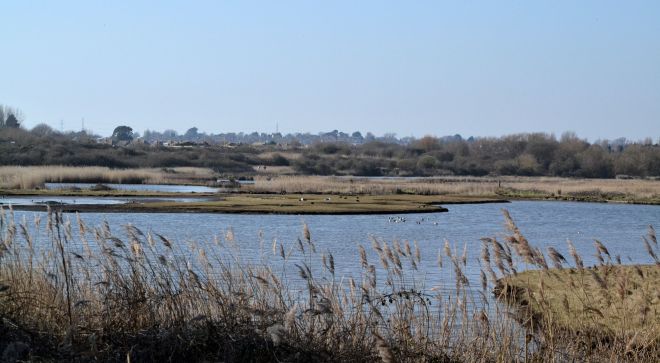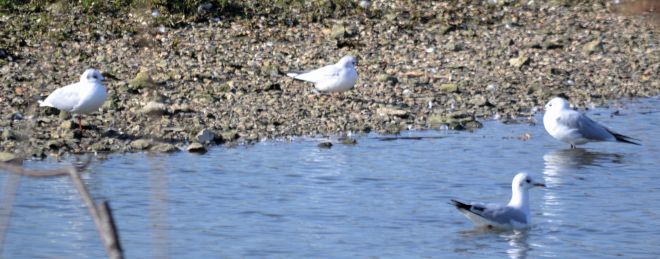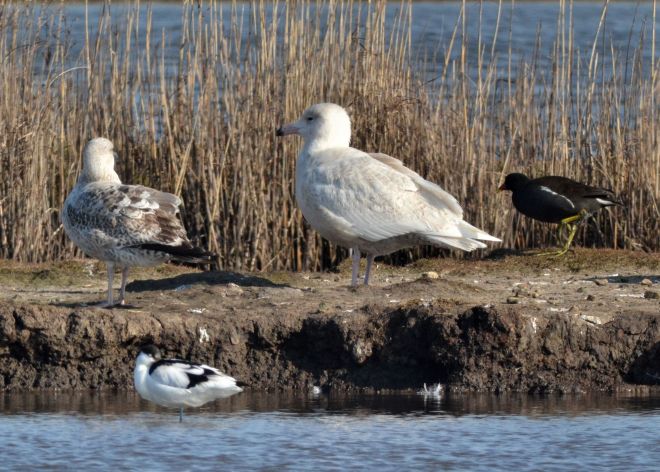At last a national bird to go after. Since my return from Florida pretty much the same scarcities as before that winter break had been reported day upon day on RBA, and nothing new within acceptable range. Then with a week of February remaining a change to very cold, clear weather coincided with the arrival of some far northern gulls. Glaucous Gull numbers were boosted nationally and an adult Ross’s Gull appeared on the south coast around Weymouth.
The second of those was a must see, being not only a lifer but a very attractive vagrant from the high Arctic that reaches England maybe once or twice a year and even less frequently on the south coast. This bird had followed a fairly regular circuit over its first three days, being seen early each morning at Ferrybridge on the causeway to Portland, then later in the day at RSPB Lodmoor to the east of the town centre. It seemed likely the visitor would stay for a while so on Saturday morning I drove down to what is a favourite area with Oxon birding colleagues Ewan and Badger.
In the interim some very nice images had appeared on Dorset Birds (see here) that whetted my appetite further to see for myself a first ever Ross’s Gull. The species breeds in the high Arctic of north America and north-east Siberia and mostly winters at the edge of the pack ice or at sea. It is similar to Little Gull in size and habits, but with a very small bill and a broader white trailing edge to the wing. Breeding adults have a neat black collar and pink-flushed underparts, while adult winters are very pale grey (above) with unmarked wings.
We arrived at Ferrybridge just after 7:30 am. On getting out of the car a bitter north-easterly wind was blowing out of Siberia. With high pressure settled over Scandinavia sunny, freezing conditions were prevailing across the whole of Europe and I reflected ruefully on how welcome such a scenario would have been last autumn. But no matter, we strode off to join a twitch line sheltering below the A354 causeway to watch and wait.
At 8:13 the day’s first Ross’s Gull report came through on people’s pagers, from Lodmoor. This was the opposite of what had happened each day until now, but the bird was said to have flown off west. So it might still settle amongst the small assembly of gulls before us in what was a very good light for taking pictures. Numbers of Red-breasted Merganser were out on the water at this far southern end of The Fleet, Brent Geese foraged here and there, while Ringed Plover and Turnstone ran around on the mud. But after two hours the Ross’s Gull had still not appeared and a decision needed to be made.

RSPB Lodmoor, one of the Ross’s Gull’s favoured haunts
Birder numbers had thinned by now and with our parking time running out we too opted to switch location to Lodmoor (pictured above). There our party was boosted to four by fellow Oxon birder Terry who had endured a similarly fruitless wait, the main attraction having not returned since that one earlier sighting. Another sojourn ensued then at 11:35 the day’s second report came from RSPB Radipole Lake close by the town centre.
Cue a mass relocation, and when we arrived at Radipole a crowd of birders was visible to one side of the visitor centre. The Ross’s Gull was dozing on the nearest island out in the reserve’s southern lagoon, then began to move around a little so everyone got to see it. I myself was able to obtain some hardly satisfactory record shots (below) but the bird had been seen, a life-list addition gained and that familiar sense of relief set in from mission having been accomplished.

Adult Ross’s Gull (centre) with Black-headed Gulls, and more record shots (below)
Eventually this delicate and delightful waif flew up high and circled the immediate vicinity, displaying a dainty, tern-like flight action with pointed wings and long sharp tail. The final departure when it came was in the direction of Lodmoor and so we followed once more.
Back at the more agreeable (to me) of the RSPB’s two Weymouth sites, being the one without visitor facilities, not a lot had changed in terms of viewable birds. But a pair of Spoonbill were feeding near the southern edge of the reserve, Avocet were dotted about then in the early afternoon two Glaucous Gull flew in, both immatures.
I had observed this large and powerful gull (pictured above) twice before in dusk roosts around Oxfordshire, so it was pleasing to take in and appreciate their paleness in the cold light of such a clear, sunny day. It has been a good winter in Britain for the Arctic’s commonest breeding gull, and these two individuals also arrived in Weymouth during the previous week.
Just before 2pm the Ross’s Gull was reported again back at Radipole Lake to where we relocated for the final time. It was in the same spot as before, but birder volumes were now more manageable and so I managed as good digiscoped images (above) as I was likely to get in the glary light with my equipment. At around 2:45 the object of our attention took off once more, flew around for a while as in the morning, and eventually disappeared from view high over Weymouth town centre. All four of us were now content with our day’s views and so we headed for home after a most successful outing.

Glaucous Gull (imm) and friends at RSPB Lodmoor, Weymouth
















